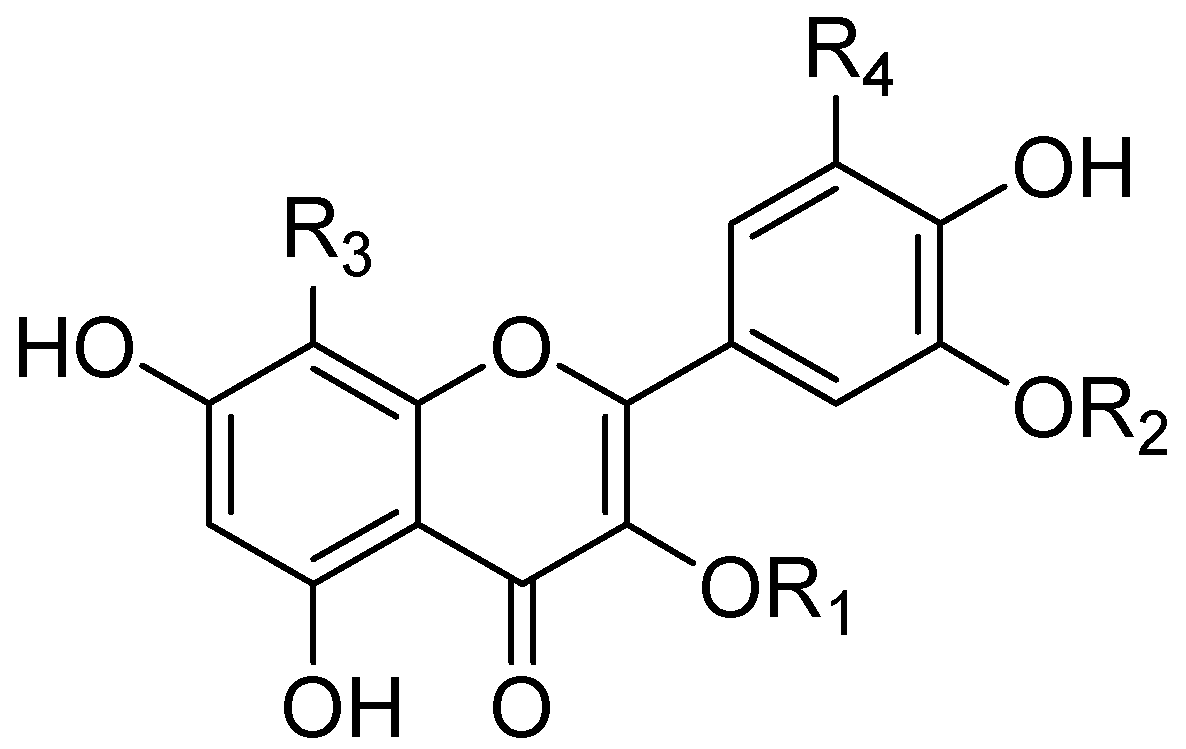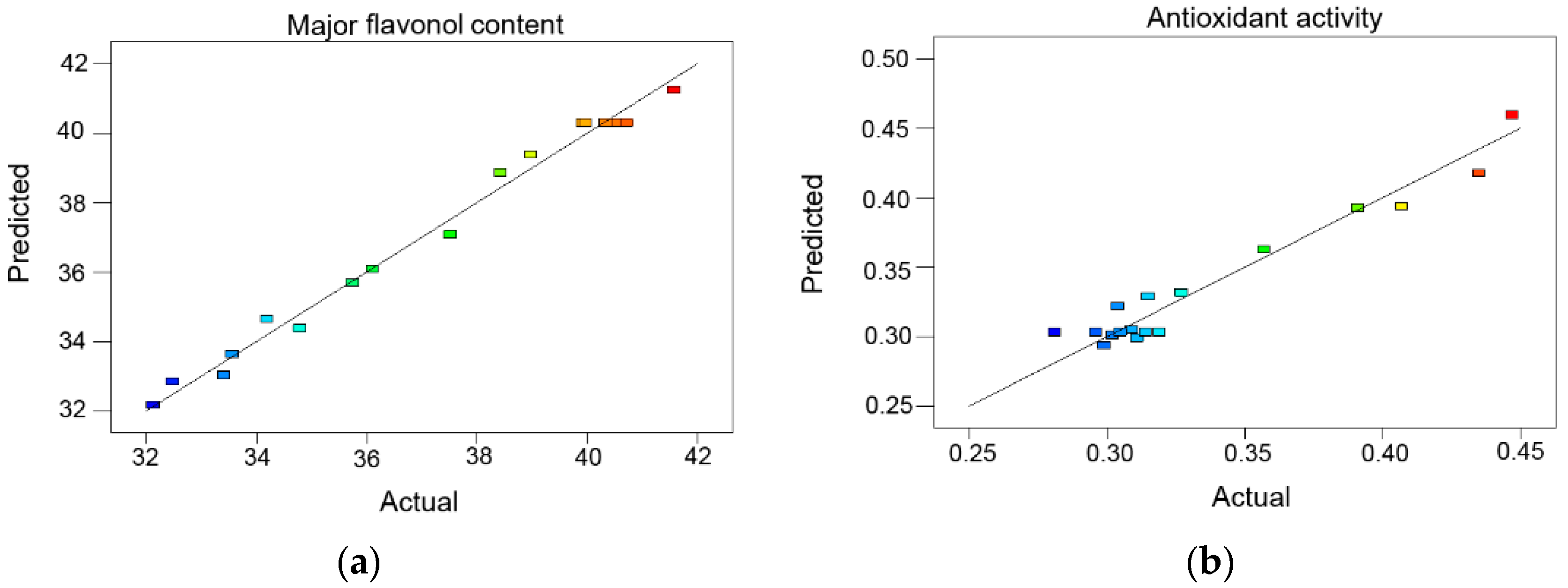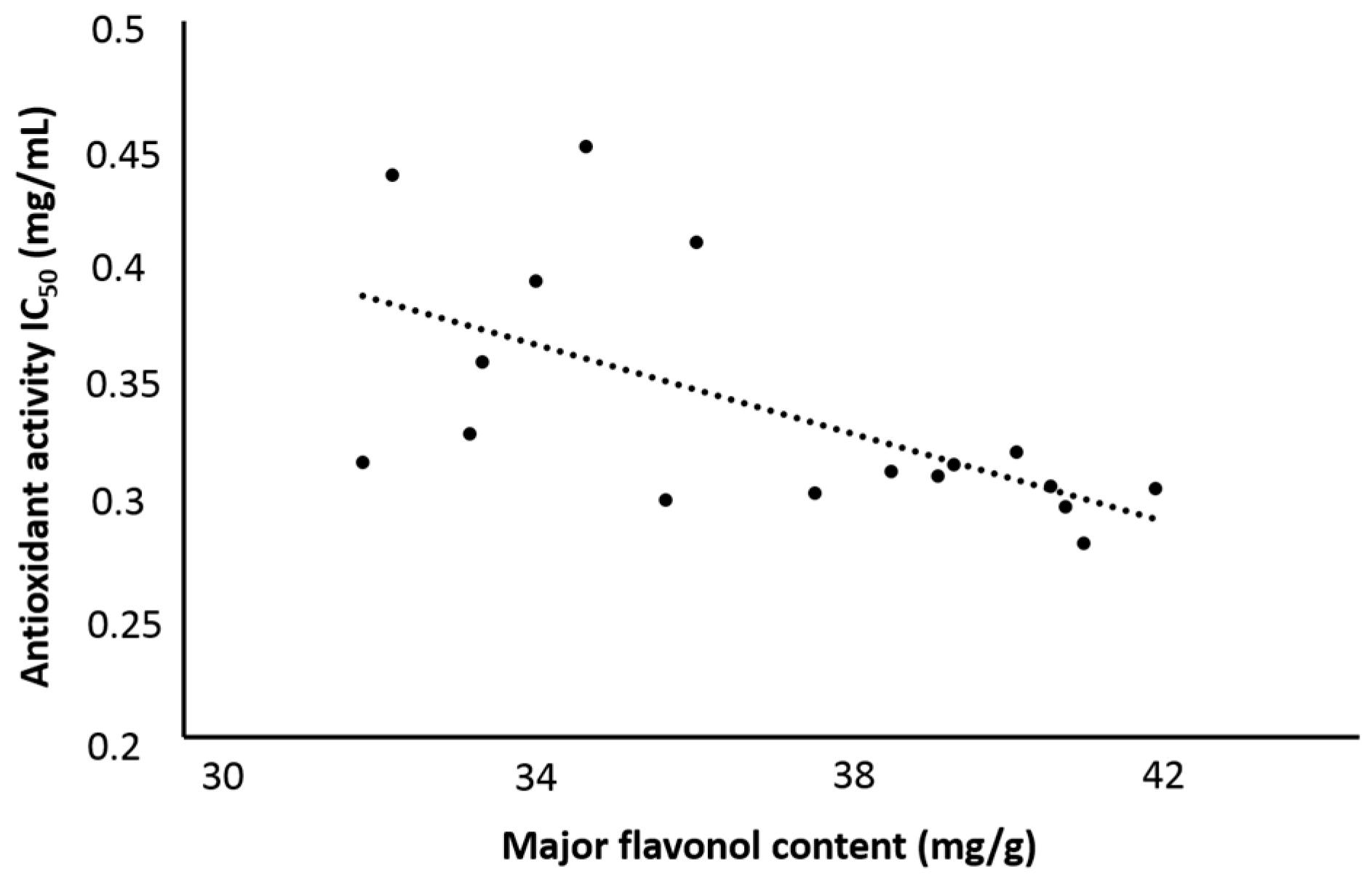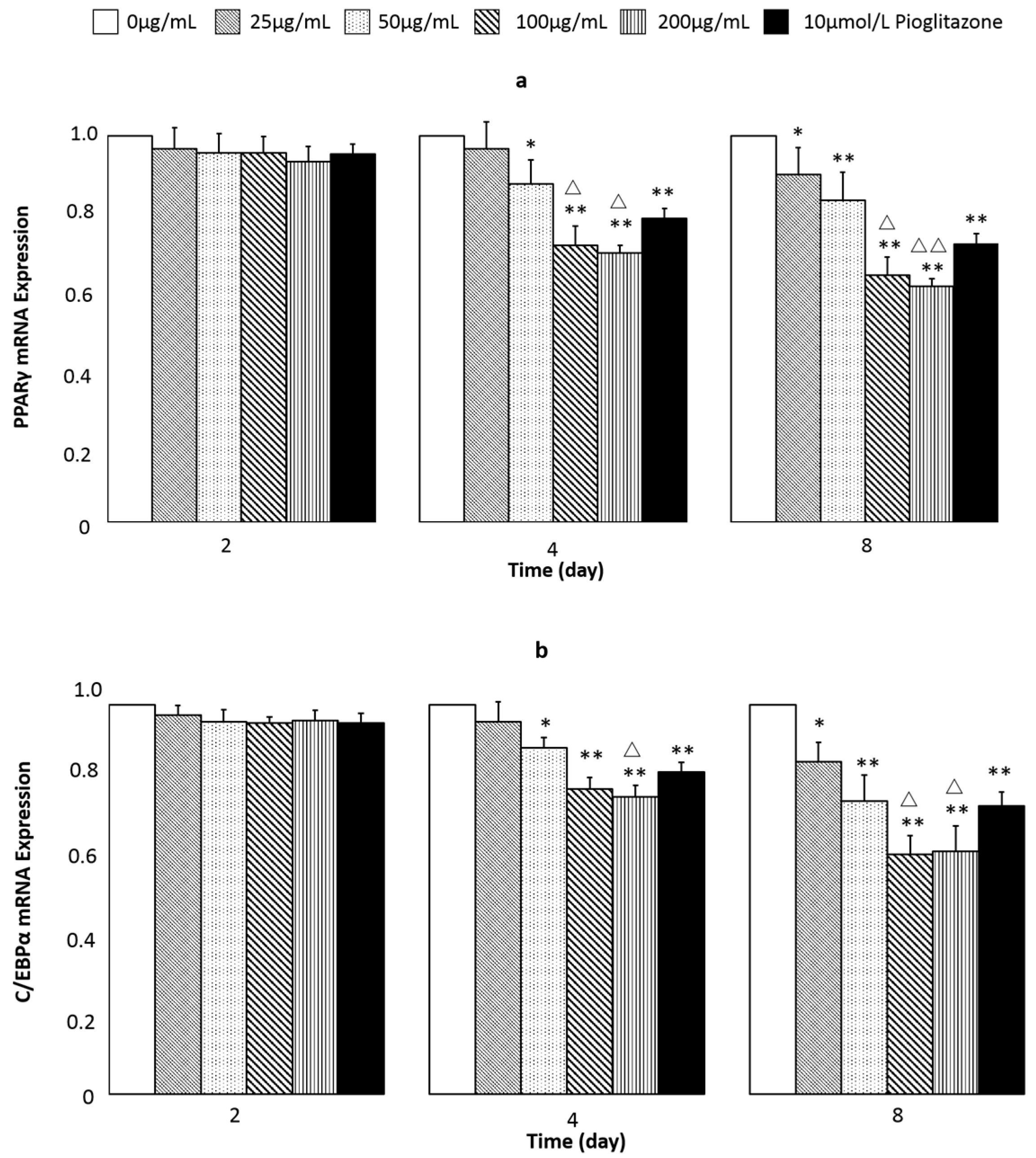1. Introduction
Abelmoschus manihot (L.) Medic is widely used in China. The flowers are an important herbal medicine for the treatment of chronic renal disease [
1,
2], diabetic nephropathy [
3], oral ulcers [
4] and burns. In recent years, the structure of its seven main flavonoids were identified as follows: rutin, hyperin, isoquercetin, hibifolin, myricetin, quercetin-3′-
O-glucoside and quercetin [
5]. Their structures are shown in
Figure 1. At present, the standard of quality for
Abelmoschus manihot in the China Pharmacopoeia (2015 Edition) is a content of hyperin of no less than 0.5% [
6]. However, hyperin is not present in sufficient quantities to determine the flavonol content in the flowers of
Abelmoschus manihot. In this study, the major flavonol content, measured as the sum of the contents of seven major pharmacological flavonoids by simultaneous HPLC determination was used as the detection index to explore the extraction process of flavonoids from the flowers of
Abelmoschus manihot.
| Compound | R1 | R2 | R3 | R4 |
| Rutin | rha→gal (β-1,6) | H | H | H |
| Hyperin | gal | H | H | H |
| Isoquercetin | glc | H | H | H |
| Hibifolin | H | H | O-glc | H |
| Myricetin | H | H | H | OH |
| Quercetin-3′-O-glucoside | H | glc | H | H |
| Quercetin | H | H | H | H |
Several techniques for the extraction of flavonoid components from herbal medicines have been studied, such as reflux extraction [
7], microwave-assisted extraction [
8], and ultrasound extraction [
9]. With the renewed attention to the environment, an excellent extractive technique should be efficient, clean and environmentally friendly. In this regard, supercritical CO
2 extraction is a perfect green technique owing to the facts it is fast, cheap and toxic solvent-free [
10]. However, supercritical CO
2 extraction is only suitable in non-polar compounds. When it is used to extract polar compounds such as flavonoids, a polar solvent is required as a modifier in the supercritical CO
2. There are no reports using supercritical fluid extraction (SFE) for flavonoids from the flowers of
A. manihot.
In the human body free radical oxidation is related to human aging and many diseases, so people are increasingly concerned about antioxidant levels. The antioxidant properties of flavonoids have been studied [
11], but less attention has been paid to the extracts obtained with SFE, especially from
A. manihot. Meanwhile, methods for antioxidant activity evaluation are receiving more and more attention, and the generally used methods are the Ferric Reducing Antioxidant Power (FRAP), 2,2-azino-bis(3-ethylbenzothiazoline-6-sulfonic acid (ABTS), Trolox Equivalent Antioxidant Capacity (TEAC) and 2,2-diphenyl-1-picrylhydarzyl (DPPH) ones [
12]. Compared with the other methods, the DPPH method is a sensitive, rapid and accurate assay for evaluating the activity of antioxidants [
13].
Obesity as a key risk factor for ill-health cannot be ignored, because it can cause type II diabetes, hypertension, coronary heart disease, and cancer [
14]. Obesity is characterized by an excessive accumulation of fat cells in the human body [
15]. It can be regulated by the differentiation of adipocytes and inhibition adipogensis from preadipocytes to adipocytes [
16]. Adipocyte differentiation is a highly regulated process, in which many kinds of transcription factors, signaling pathways and miRNA are required [
15]. Among the various types of transcription factors, peroxisome proliferator-activated receptor-γ (PPARγ) and CCAAT/enhancer binding protein α (C/EBPα) play an important role in adipocyte differentiation [
17], which can upregulate the expression of enzymes and functional proteins which are related to lipid accumulation and lipid metabolism.
In this study, we investigated: (i) the effects of SFE extraction parameters including pressure, temperature and ethanol concentration in the yield of major flavonol and antioxidant activity using a response surface methodology based on a Box-Behnken experimental design; (ii) the relationship between the flavonol content and antioxidant activity under the optimum condition; (iii) the effects of extracts on PPARγ and C/EBPα expression at mRNA using the 3T3-L1 cell line.
3. Discussion
With the economic development of society and the resulting different lifestyles, obesity has become one of the most common nutritional imbalance disorders. More and more people suffer from obesity, and research into natural anti-obesity products has become a hot topic in recent years [
21]. For a long time, SFE technology was mainly used to extract nonpolar substances because supercritical CO
2 has low polarity. A certain concentration of co-solvent is necessary to improve the separation efficiency of flavonoids using supercritical CO
2 extraction. SFE is influenced by many extraction parameters, including pressure, temperature, volume of co-solvent, extraction time, modifier constituent and so on. Traditional experiment designs change one variable at a time. However it is hard to estimate the relationship between the variables. In this study, three main influencing factors were screened out by previous single-factor experiments, then a Box-Behnken experimental design with three variables at three levels was used, which allows us to determinate the interactions among the factors and improve the quality of prediction [
22]. According to ANOVA, pressure and ethanol content had significant effects on the major flavonol content and antioxidant activity. It was believed that the solubility of flavonoids increased at a given concentration range of ethanol/water, which could be explained by the fact of a similar polar solvent dissolving a similar polar solute. However, excessive ethanol concentration would decrease extraction rates with the increase of liposoluble components. Pressure was also in favor of the extraction of flavonoids, but further increases in pressure didn’t improve the yield due to the repulsive solvent interaction. The optimum experimental conditions predicted by the mathematical models was pressure 20 MPa, temperature 53 °C and ethanol content 85%. The results of the prediction agree well with the actual values. Furthermore, there is no significant difference between SFE and Soxhlet extraction methods. It is thus revealed that SFE is an efficient technique for flavonoid extraction from the flowers of
A. manihot. This is the first study to analyze extraction efficiency by the sum of the contents of seven major pharmacological flavonoids in the flower of
Abelmoschus manihot.
It is believed that flavonoids are the primary contributors to the antioxidant activity of the flowers. However, the experimental results showed the maximum flavonol yield didn’t correspond to the minimum IC
50 value, which means there are some other components contributing the antioxidant activity (
Figure 6). Based on the above analysis, further research to look for new plant-based antioxidant compounds is warranted.
3T3-L1 is recognized as a model for the study of adipocyte differentiation [
23]. After treatment with the differentiation mixture culture (containing insulin, DEX, IBMX), 3T3-L1 preadipocytes progress to adipocytes. Two important transcription factors include CCAAT/enhancer binding protein family (C/EBPs) and peroxisome proliferators-activated receptor family (PPARs) were found in the differentiation process [
23].
It is found that C/EBPs, including C/EBP-α, β and δ, are important transcription factors in adipocyte differentiation [
24]. Research on the tumor suppressor p53 shows that the expression of its downstream genes can be activated while binding with C/EBPα, thus blocking cell proliferation and turning to differentiation [
25]. C/EBPβ can be bound to the binding sites of many gene promoters to regulate their expression [
26]. C/EBPδ, as a transcriptional activator, takes part in adipocyte differentiation in the early stage [
27]. PPARs control many cellular metabolism. PPARγ, as an important member of the family, is responsible for cell differentiation and transcription. A study found that PPARγ-deficient preadipocyte can’t be induced into adipocytes with any factor’s stimulation [
28]. When PPARγ the plasmid was transfected into 3T3-L1 preadipocytes, the cells can spontaneously differentiate into adipocytes [
29]. It indicates that PPARγ is a necessary factor for fat formation.
During the process of in vitro cell culture, the expression of C/EBPβ and C/EBPδ is transiently induced in early stage of differentiation. Subsequently, the expression of PPARγ and C/EBPα is induced, which activate a large number of downstream target gene expressions. Finally, preadipocytes differentiate into adipocytes [
30]. PPARγ and C/EBPα play essential roles in the differentiation progress, as both of them are key adipocyte marker genes on the adipocyte differentiation of 3T3-L1 cells [
23]. Therefore, to investigate the effects of extracts on the adipogenesis, 3T3-L1 preadipocytes were treated with various concentrations of extracts during differentiation. Our data showed that the extracts significantly attenuated the expression of PPARγ and C/EBPα compared with adipocytes, revealing that the extracts inhibited adipogenesis in the 3T3-L1 cells by down-regulating PPARγ and C/EBPα expression.
Based on above analysis, we believe extracts from SFE with noticeable antioxidant and anti-adipogenic activity have potential to become a drug or health care product for the prevention and treatment of obesity.
4. Materials and Methods
4.1. Materials
The flowers of A. manihot were obtained from Suzhong Pharmacy (Taizhou, China). The flowers were ground using an herbal pulverizer (FW 100, Tianjin Taisite Instrument Co. Ltd., Tianjin, China) and sieved to obtain the particles smaller than 0.3 mm. Rutin, hyperin, isoquercetin, myricetin, and quercetin standards were purchased from the National Institutes for Food and Drug Control (Beijing, China). Hibifolin and quercetin-3′-O-glucoside were made in the lab. DPPH was supplied by Sigma-Aldrich Co. Ltd. (Shanghai, China). The mouse embryo 3T3-L1 cell line was obtained from the American Type Culture Collection (Manassas, VA, USA) and cryopreserved at the Department of Biochemistry of China Pharmaceutical University. Dulbecco′s modified eagle medium (DMEM) and fetal bovine serum (FBS) were purchased from JianCheng Bioengineering Institute (Nanjing, China). Insulin, dexamethasone (DEX), dimethyl sulfoxide (DMSO), 3-isobutyl-1-methylxanthine (IBMX) and Rneasy MiNi Kit was purchased from QIAGEN (Germantown, MD, USA). RT PrimeScript Kit and SYBR Premix Ex Taq were purchased from TaKaRa (Dalian, China). CO2 (Fangxin Gas Ltd., Ningbo, China, purity 99.5%) was used in all extraction experiments. Pioglitazone was purchased from Takeda Co. (Tokyo, Japan). All other solvents were analytical or chromatographic grade.
4.2. Modified Supercritical CO2 Extraction Procedure
A Spe-ed SFE-2 system (Applied Separation, Franklin, PA, USA) was used for all extraction, which operates with two pumps, a master pump for delivery of CO2 and second pump (Knauer pump, model K-501, Berlin, Germany) for the addition of modifier. An accurately weighed quantity of the grounded sample (about 0.5 g) was placed in a 10 mL volume extraction vessel (60 × 15 mm, i.d.) sandwiched with Celite. Before starting of extraction process the extraction vessel was preheated by oven for 10 min. The extraction conditions were as follows: pressure from 10 to 30 MPa; temperature from 40 to 60 °C; ethanol concentration from 60% to 90% (ethanol–water, v/v); flow-rate of CO2 (gaseous state), 2 L/min; flow-rate of modifier, 0.4 mL/min (correspond to 8% modifier). Inserting restrictor outlet into a vial containing ethanol collected extract. The collection vial was placed in an ice-water batch to aid trapping. The final volume of the extract was adjusted to 50.0 mL ethanol. This solution was utilized for HPLC detection. Dry products were removed solvents by rotary evaporation. Different concentrations of the products were made (25, 50, 100, 200 μg/mL) for DPPH radical scavenging activity assay and 3T3-L1 cell culture.
4.3. HPLC Analysis
A high-performance liquid chromatography system (Hitachi, Tokyo, Japan) equipped with a Hitachi pump (model L-2130) and an ultraviolet-visible detector (Hitachi, model L-2400) was used. Analysis condition was as follows: Diamonsil C18 collumn (5 μm, 250 × 4.6 mm i.d., Dikma Technologies, Beijing, China); The mobile phase was A (acetonitrile) and B (0.2% phosphoric acid) in a step gradient manner (0–10 min, 15%–18% A; 10–30 min, 18%–23% A; 30–40 min, 23% –30%A; 40–50 min, 30%–40% A; 50–60 min, 40%–15%A) ; flow-rate, 1 mL/min; detection wavelength, 360 nm.
Qualitative HPLC chromatography was performed on seven standards as follows: rutin, hyperin, isoquercetin, hibifolin, myricetin, quercetin-3′-
O-glucoside and quercetin. Linear regression analysis for each of the seven standards was performed by plotting the peak area (Y) versus content (X, ng/mL). The linear calibration curves, linear ranges and correlation coefficients (R
2) are shown in
Table 4. The extraction yields of seven compounds for all experiments were calculated by the calibration curves. The sum of the contents of the seven pharmacologically active flavonoids was taken as the major flavonoid content.
4.4. DPPH Radical Scavenging Activity Assay
The DPPH radical assay has been widely used to evaluate the antioxidant activity of various active materials. DPPH radical scavenging activity was tested according to the method [
31] with some modifications. Briefly, each extract was diluted with ethanol to form a series of concentration gradients. One hundred μL of each sample solution was added to 96- well plate, and then mixed with 100 μL of ethanol solution containing DPPH radicals (0.2 mmol/L). After incubation for 30 min at room temperature in the dark, the absorbance of reactants was measured at 517 nm in a Benchmark plus microplate spectrophotometer reader (Bio-Rad, Philadelphia, PA, USA). Antioxidant activity was expressed as an inhibition percent of DPPH radical and calculated from Equation (3):
where
was the absorbance of the control (without extract);
was the absorbance of the sample. Then the antioxidant activity was shown as the effective concentration at 50% (IC
50 value), the concentration of sample required to scavenge 50% DPPH free radicals, were calculated by nonlinear regression analysis and expressed in mg/mL.
4.5. Box-Behnken Experimental Design
In this work, a Box-Behnken experimental design with three variables at three levels was used, which allows us to determine the interactions among the factors and improve the quality of prediction [
22]. The software Design Expert (Stat-Ease Inc., Minneapolis, MN, USA) was employed for experimental design, model building and data analysis.
The effect of extraction pressure (X
1), temperature (X
2) and ethanol content (X
3) on major flavonoids content (Y
1) and IC
50 value of antioxidant activity (Y
2) was investigated using a Box-Behnken statistical model. The 17 runs of independent variables and responses are shown in
Table 5.
4.6. Statistical Analysis
A second-order polynomial model was used to evaluate the relationship between the response and the variables, which can be expressed as the following Equation (4):
where Y is the predicted response; X
1 − X
3 are independent factors that influence the response Y; β
0 is a constant; β
1 − β
3 are the linear coefficients for the main variable effects, β
11, β
22 and β
33 are quadratic coefficients, β
12, β
13 and β
23 are interaction coefficients. Analysis of variance (ANOVA) was employed to analyze the chosen model and view the results. The statistical significant difference was defined as a probability (
p-value) less than 0.05 and coefficient of determination (
R2) greater than 0.900.
4.7. Soxhlet Extraction
A known quantity of ground sample (about 0.5 g) was accurately weighed into an extraction thimble. Extractions were carried out in a Soxhlet extractor with 50 mL of 95% ethanol in an 87 °C water bath. After 28 cycles in the Soxhlet equipment, the extracts were transferred to a 50 mL volumetric flask and made up to the mark with 95% ethanol.
4.8. 3T3-L1 Cell Culture and Adipocyte Differentiation
In 6-well plates, 3T3-L1 preadipocytes were grown in DMEM supplemented with 10% FBS and antibiotics (100 units/mL penicillin and 100 g/mL streptomycin). The culture was maintained in a 5% CO2 atmosphere at 37 °C. Two days post-confluence, 3T3-L1 cells (designated as day 0) were stimulated by a differentiation mixture culture containing 1 μM DEX, 0.5 mM IBMX and 1 μg/mL insulin in DMEM with 10% FBS for 3 days (days 0–2). Then cells were incubated in the medium with DMEM containing 10% FBS and 10 μg/mL insulin for 2 days further (days 3–4), and thereafter incubated in DMEM containing 10% FBS and refreshed at 2 day intervals (days 5–8). Dosage groups: adding the final concentration of 25, 50, 100 and 200 μg/mL extracts in the above cell culture fluid from day 0 to 8. Pioglitazone groups were given 10 μmol/L pioglitazone in the whole cell culture process.
4.9. Real-Time PCR Detection Cell Differentiation Marker Genes
Total RNA was extracted from the 3T3-L1 cells by an Rneasy MiNi Kit from the normal and dosage and pioglitazone groups on days 2, 4 and 8, and reverse transcription and real-time PCR were performed by a RT PrimeScript Kit and SYBR Premix Ex Taq, respectively.
Table 6 shows the primer sequences that were synthesized by Sangon Biotech Co., Ltd. (Shanghai, China). To enable comparison of Ct (cycle threshold) values between groups, quantities of all target genes in the test samples were normalized by GAPHD. The results of relative mRNA expression were used in formula:
| 2−△△Ct, △Ct = Ct value (target gene) − Ct value (GAPHD), △△Ct = △Ct (dosage | (5) |
| group) − △Ct (control group) |
All results obtained were expressed as mean ± SD. Statistical analysis was performed using the SPSS software (22.0 version; IBM, Armonk, NY, USA). Significant differences (p < 0.05) were determined by One-way ANOVA.













